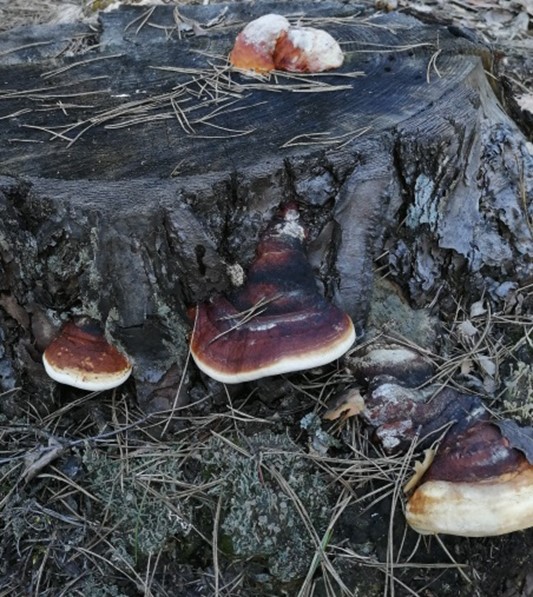ANTIOXIDANT PROPERTIES OF THE FOMITOPSIS PINICOLA TRUNE EXTRACT IN THE COMPOSITION OF POLYETHYLENE FILMS
UDC 544.234.6:678.742.2:678.046.5/.6
Abstract
Scientific literature shows that the thallus of Fomitopsis pinicola is sufficiently rich in secondary metabolites with pronounced antioxidant properties. However, the experiments showed that ethanol extracts of F. pinicola compared with extracts of higher plants (for example, Chelidonium majus) were characterized by low antioxidant properties, both in the polymer composition and according to biochemical analysis. The induction period of oxidation of polyethylene films with extracts of F. pinicola was 3.25 times lower than the induction period of oxidation of similar polymer films with C. majus extracts. It is assumed that this result is a consequence of the presence of most phenolic compounds of F. pinicola within melanins. In the composition of these pigments, phenolic compounds are sedentary and cannot diffuse in the polymer melt. In addition, a number of reactive functional groups will not exhibit their antioxidant properties because of spatial difficulties.
Extraction conditions (extractant, time), under which the obtained F. pinicola extracts confirm high antioxidant properties in polyethylene films, significantly exceeding the antioxidant properties of C. majus extracts, were experimentally determined during the studies. It is shown that to obtain highly effective antioxidant F. pinicola extracts for polymer stabilization it is most rational to use acetone as an extractant. The recommended extraction time is at least 5 days.
Downloads
Metrics
References
Kostromina Ye.O., Chkhenkeli V.A. Sovremennyye problemy i perspektivy razvitiya APK, 2014, pp. 43–48. (in Russ.).
Payamnoor V., Kavosi M.R., Nazari J. Journal of Forestry Research, 2020, vol. 31, no. 4, pp. 1381–1390. DOI: 10.1007/s11676-019-00892-2.
Bishop K.S. Nutrients, 2020, vol. 12, no. 3, p. 609. DOI: 10.3390/nu12030609.
Grienke U. et al. Journal of Ethnopharmacology, 2014, vol. 154, no. 3, pp. 564–583.
Nosov A.I., Sysoyeva M.A., Grevtsev V.A., Khalitov F.G. Khimiya rastitel'nogo syr'ya, 2013, no. 3, pp. 195–200. (in Russ.).
Ding J.L., Shin H.J., Cha W.S. Journal of Life Science, 2006, vol. 16, no. 7, pp. 1123–1126. DOI: 10.5352/JLS.2006.16.7.1123.
Zahid M.T. et al. Journal of Natural Sciences Research, 2020, vol. 10, no. 2, pp. 58–68.
Yoshikawa К., Inoue M., Matsumoto Y., Sakakibara C., Miyataka H., Matsumoto H., Arihara S. Journal of natural products, 2005, vol. 68, pp. 69–73.
Striegler S., Haslinger E. Monatshefte fur chemie chemical monthly, 1996, vol. 127, pp. 755–761.
Fedotov O.V., Veligodskaya A.K. Biotechnologia Acta, 2014, vol. 7, no. 1, pp. 110–116. (in Russ.).
Zhao J. et al. Phytochemistry, 2018, vol. 152, pp. 10–21. DOI: 10.1016/j.phytochem.2018.04.012.
Meredith P., Sarna T. Pigment cell research, 2006, vol. 19, no. 6, pp. 572–594. DOI: 10.1111/j.1600-0749.2006.00345.x.
Shivrina A.N. Biologicheski aktivnyye veshchestva vysshikh gribov. [Biologically active substances of higher fungi]. Leningrad, 1965, 199 p. (in Russ.).
Choi D.B. et al. Biotechnology and Bioprocess Engineering, 2007, vol. 12, no. 5, pp. 516–524. DOI: 10.1007/BF02931349.
Angelini P. et al. International Journal of Medicinal Mushrooms, 2018, vol. 20, no. 11, pp. 1047–1063.
Sysoyeva M.A., Kuznetsova O.Yu., Gamayurova V.S., Sukhanov P.P., Ziyatdinova G.K., Budnikov G.K. Vestnik Ka-zanskogo tekhnologicheskogo universiteta, 2004, no. 1, pp. 244–250. (in Russ.).
Tai S. H. et al. RSC advances, 2019, vol. 9, no. 59, pp. 34184–34195. DOI: 10.1039/c9ra05899k.
Rösecke J., König W.A. Phytochemistry, 1999, vol. 52, no. 8, pp. 1621–1627. DOI: 10.1016/S0031-9422(99)00349-0.
Sysoyeva M.A., Khabibrakhmanova V.R., Gamayurova V.S., Kyyamova G.I. Khimiya rastitel'nogo syr'ya, 2009, no. 4, pp. 117–122. (in Russ.).
Vorobyova E.V., Prikhod'ko Ye.L. Khimiya rastitel'nogo syr'ya, 2021, no. 1, pp. 241–250. DOI: 10.14258/jcprm.2021018262. (in Russ.).
Vorobyova E.V., Prikhod'ko Ye.L. Khimiya rastitel'nogo syr'ya, 2019, no. 2, pp. 213–223. (in Russ.).
Samper M.D. et al. Journal of Applied Polymer Science, 2013, vol. 129, no. 4, pp. 1707–1716.
Mal'tseva Ye.M., Yegorova N.O., Yegorova I.N. Vestnik ural'skoy meditsinskoy akademicheskoy nauki, 2011, no. 3-1, pp. 68–69. (in Russ.).
Popova A.V. et al. IOP Conference Series: Earth and Environmental Science. IOP Publishing, 2021, vol. 624, 012173. DOI: 10.1088/1755-1315/624/1/012173.
Tarasevich B.N. IK spektry osnovnykh klassov organicheskikh soyedineniy. [IR spectra of the main classes of organic compounds]. Moscow, 2012, 55 p. (in Russ.).

Copyright (c) 2023 chemistry of plant raw material

This work is licensed under a Creative Commons Attribution 4.0 International License.

This work is licensed under a Creative Commons Attribution 4.0 International License.
The authors, which are published in this journal, agree to the following conditions:
1. Authors retain the copyright to the work and transfer to the journal the right of the first publication along with the work, at the same time licensing it under the terms of the Creative Commons Attribution License, which allows others to distribute this work with the obligatory indication of the authorship of this work and a link to the original publication in this journal .
2. The authors retain the right to enter into separate, additional contractual agreements for the non-exclusive distribution of the version of the work published by this journal (for example, to place it in the university depository or to publish it in a book), with reference to the original publication in this journal.
3. Authors are allowed to post their work on the Internet (for example, in a university repository or on their personal website) before and during the review process of this journal, as this may lead to a productive discussion, as well as more links to this published work.











